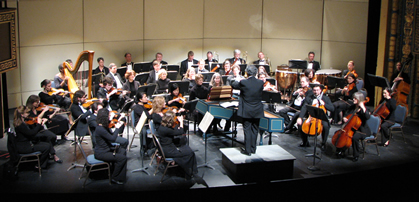The venerable Asheville Chamber Music Series has engaged many fine artists since the launch of its first concert in 1952. The vast majority of their performances have featured the standard literature for strings — either classic string quartets, or strings with piano, such as duos or trios — and a glance at their current season bears out this proclivity. With this concert, however, new territory was tested with Windscape, an extraordinary wind quintet that delights in playing their own arrangements of the music of non-wind composers. One senses their impatience with the limitations of the standard wind repertory when they explain their overriding reason for playing their spectacular transcriptions — the need to perform good music. The large audience at the Unitarian Universalist Church of Asheville was treated to an afternoon of exceptional music making by these giants in the wind world.
Space won’t allow more than a cursory introduction to the ensemble members. Flutist Tara Helen O’Connor is a current artist member of the Chamber Music Society of Lincoln Center and is professor of flute at the Purchase College Conservatory of Music, Bard College Conservatory of Music, Manhattan School of Music Contemporary Music Program, and teaches summer master classes at the Banff Centre in Canada. Randall Ellis is principal oboist of Lincoln Center’s Mostly Mozart Festival Orchestra and is principal oboist and serves on the faculty of the Eastern Music Festival in Greensboro, NC. He is instructor of oboe at Skidmore College in Saratoga Springs, NY. Alan R. Kay is co-principal clarinetist and a former Artistic Director of Orpheus Chamber Orchestra and is principal clarinet with New York’s Riverside Symphony and the Little Orchestra Society, and is principal clarinet with the American Symphony and the Orchestra of St. Luke’s. He also appears regularly with the Chamber Music Society of Lincoln Center. David Jolley, french horn, is professor of horn at Queens College-CUNY, Mannes College of Music, and the NC School of the Arts. Bassoonist Frank Morelli is a member of the Festival Chamber Music Society and serves on the faculties of the Juilliard School, the Yale and Manhattan Schools of Music and SUNY Stony Brook, and is principal bassoonist of the New York City Opera Orchestra, Orpheus, and the American Composers Orchestra.
The program consisted of the ensemble’s “favorites,” and opened with the Fantasia and Fugue in D minor, S. 905 by J.S. Bach arranged by Kay. The case was made in their opening remarks that, as the organ is actually a sort of wind instrument, transcribing its music for wind quintet is actually not that much of a stretch. What was most impressive here was the group’s flawless sense of style — elasticity in the fantasia which lent just the right air of “written-down improvisation” and meticulous observance of what was subject, countersubject, and episodic material in the fugue which blazed in perfectly coordinated execution, just like clockwork.
Next were Six Bagatelles by György Ligeti who was born in Transylvania, Romania of Hungarian parents. These pieces were arranged by the composer himself for wind quintet from his own larger set of eleven bagatelles for piano composed in 1953. Far from being mere trifles, they challenge the listener with their dissonant vocabulary and extreme swings of mood, and provide multiple technical challenges for each player. The opening Allegro proved to be a madcap movement of repetitive, insistent phrases, most of these within a relatively narrow range, showing the influence of eastern European folk music. The slow-to-a-stop ending was made hilarious by the bassoon’s last-and-very-late final note. The second movement Rubato: Lamentoso was changeable, both by turns lyrical and stridently declamatory. There were extraordinary sound effects — one of them being a ringing dissonance reminiscent of the clanging of bells. The Allegro grazioso was anchored by a downwardly cascading ostinato in the bassoon, which later invaded the flute part and high melodic fragments in the horn. The dissonant Presto ruvido preceded the haunting Adagio. Mesto, which was in homage to Béla Bartók. Its dissonant dark harmonies and searching melodies containing the “Scotch-snap” rhythm figure so prominently in Bartók’s music. The final Molto vivace, Capriccioso movement was the boldest of all, with shifting meters and tempi and a general mood of extroverted fun, what one ensemble member likened to a “Transylvania Tech fight song.”
The last piece before intermission was Ravel’s Ma mere l’oye (Mother Goose), a charming five-movement suite of character pieces composed initially for piano four hands and then later orchestrated. In Morelli’s arrangement, maximum use was made of the additional instruments of English horn and piccolo in addition to the standard quintet members. Exquisite attention was paid to tone production and the sensuous play of timbres, singly and in conjunction with one another. Whereas the other works on the program were encoded with a strong rhythmic drive, this was successfully suspended in this floating and color-filled time warp.
The sole piece after intermission was Dvořák’s Quartet for Strings No. 10, Op. 51 in E-flat arranged by Jolley. Dvořák’s writing here is neither complex nor obtuse, but sunny and accessible in a folksy manner. The beginning motives in the opening Allegro man non troppo sound much like a wafting breeze which emanates from the bassoon. Dvořák’s formal markers, octaves, frequently articulate the formal divisions within the movement. The second movement Dumka, an elegiac movement with sections which alternated in tempo and mood, was impressive for its expressive depth. The third movement Romanza: Andante con moto was a stunning exploration of Dvořák’s lyrical style, though tinged with moodiness. The finale was simply brilliantly played, with doublings right in sync and the swirl of competing parts expertly voiced.
If this weren’t enough, Windscape performed O’Connor’s blazing arrangement of Bernstein’s Overture to Candide at a take-no-prisoners tempo that thrilled the audience to their feet in a standing ovation. One can only marvel at the skill of each player and how together they make it all work at the highest artistic level.











